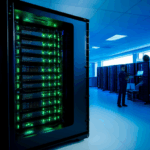“`html
The Hidden Risks in Your Network: How to Protect Yourself
Introduction
Network security is a critical aspect of protecting digital assets, whether you’re an individual or a business. It involves safeguarding your network infrastructure, data, and applications from unauthorized access, theft, and damage. However, many people underestimate the complexity and breadth of network threats, often overlooking hidden risks that can lead to significant breaches.
Understanding these hidden risks is crucial because even minor oversights can result in major security breaches. Common misconceptions include believing that antivirus software alone is sufficient or that once a network is set up, it remains secure indefinitely. In reality, network security requires constant vigilance and proactive measures.
Section 1: Understanding Common Network Risks
Prevalent Threats
The most common threats to network security include malware, phishing attacks, and unauthorized access. Malware can infiltrate networks through email attachments, malicious websites, or infected USB drives. Phishing attacks trick users into revealing sensitive information, often by posing as legitimate entities. Unauthorized access can occur when hackers exploit vulnerabilities in network configurations or use stolen credentials.
These risks can enter your network through various channels. Email is a frequent vector for malware and phishing attacks. Web browsing on insecure sites can expose your network to malware. Unsecured Wi-Fi networks make it easy for attackers to intercept traffic and gain access to your network.
Real-World Examples
Consider the Target breach in 2013, where hackers gained access to the company’s network through a third-party vendor’s credentials. This incident underscores the importance of securing all entry points, not just direct connections. Another example is the Equifax breach in 2017, where outdated software left the company vulnerable to a massive data leak. These cases highlight the need for robust security practices across all aspects of network management.
Section 2: Identifying Hidden Risks
Less Obvious Vulnerabilities
While the risks mentioned above are well-known, there are also less obvious vulnerabilities that can compromise your network. Weak passwords, outdated software, and misconfigured devices are common culprits. For instance, using default passwords or simple combinations makes it easier for attackers to gain access. Failing to update software regularly leaves your network exposed to known vulnerabilities.
Social engineering tactics exploit human behavior to gain network access. Attackers may impersonate trusted contacts or create fake scenarios to extract sensitive information. These tactics are particularly effective because they bypass traditional security measures. Additionally, IoT devices and cloud storage services present unique risks due to their widespread adoption and often lax security standards.
Section 3: Best Practices for Protecting Your Network
Essential Steps
To secure your network, start with strong password policies. Use complex, unique passwords for each account and enable multi-factor authentication (MFA) wherever possible. Regularly update software to patch known vulnerabilities. Install and maintain firewalls to control inbound and outbound traffic.
Encryption is crucial for protecting data in transit and at rest. Implement encryption protocols like SSL/TLS for web communications and AES for stored data. Multi-factor authentication adds an extra layer of security by requiring more than just a password. Intrusion detection systems (IDS) monitor network traffic for suspicious activity and alert administrators in real-time.
Secure Wi-Fi Networks and IoT Devices
Set up secure Wi-Fi networks by enabling WPA3 encryption and disabling SSID broadcasting. Change default admin credentials and ensure that only authorized devices can connect. For IoT devices, use strong passwords, keep firmware updated, and limit their network access to only necessary resources. Regularly review device permissions and disable unused features to minimize potential attack surfaces.
Section 4: Monitoring and Responding to Threats
Continuous Monitoring and Logging
Continuous monitoring and logging are essential for maintaining network security. Monitor network traffic, user activities, and system logs to detect anomalies early. Set up alerts for unusual patterns or failed login attempts. Regularly review logs to identify potential threats and address them promptly.
Detecting and Responding to Suspicious Activity
Early detection of suspicious activity can prevent major breaches. Look for signs like unexpected data transfers, unusual login times, or unauthorized access attempts. When you detect suspicious activity, isolate affected systems and investigate thoroughly. If necessary, engage cybersecurity professionals to assist with containment and recovery efforts.
Staying Informed
Stay informed about new threats and emerging technologies by following reputable cybersecurity blogs, subscribing to newsletters, and participating in industry forums. Consider attending workshops or certifications to enhance your knowledge and skills in network security.
Conclusion
In summary, network security is a multifaceted challenge that requires continuous attention and adaptation. By understanding common risks, identifying hidden vulnerabilities, implementing best practices, and monitoring your network, you can significantly reduce the likelihood of a breach. Take proactive measures to protect your network and remain vigilant against evolving threats.
Remember, network security is an ongoing process. Stay informed, adapt to new challenges, and continuously improve your security posture. With the right strategies and tools, you can safeguard your network and ensure the privacy and integrity of your data.
“`


